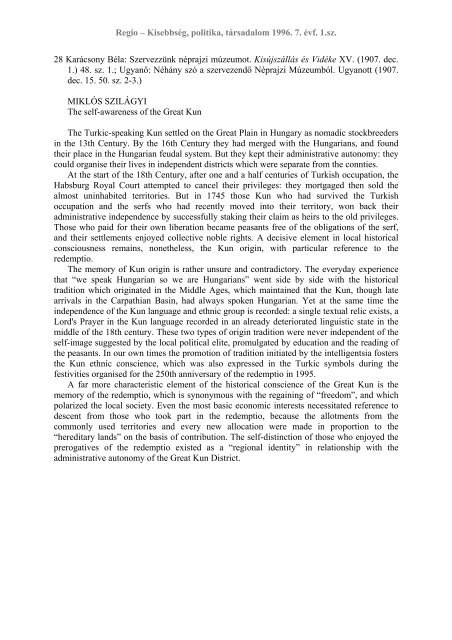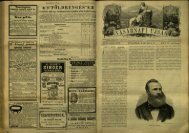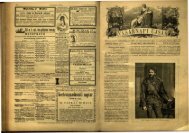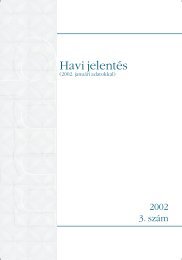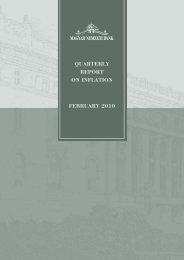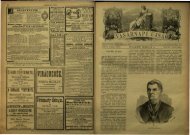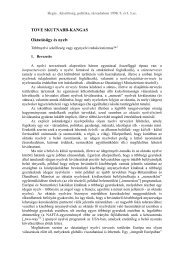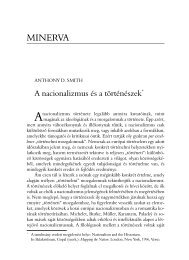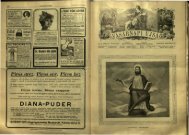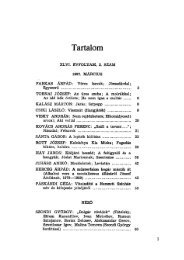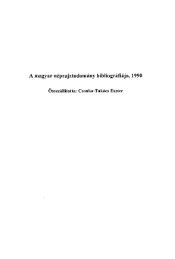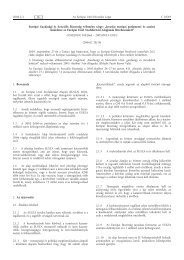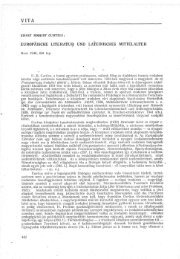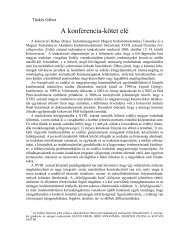Regio â Kisebbség, politika, társadalom 1996. 7. évf. 1.sz.
Regio â Kisebbség, politika, társadalom 1996. 7. évf. 1.sz.
Regio â Kisebbség, politika, társadalom 1996. 7. évf. 1.sz.
Create successful ePaper yourself
Turn your PDF publications into a flip-book with our unique Google optimized e-Paper software.
<strong>Regio</strong> – Kisebbség, <strong>politika</strong>, társadalom <strong>1996.</strong> <strong>7.</strong> évf. <strong>1.sz</strong>.<br />
28 Karácsony Béla: Szervezzünk néprajzi múzeumot. Kisújszállás és Vidéke XV. (190<strong>7.</strong> dec.<br />
1.) 48. sz. 1.; Ugyanő: Néhány szó a szervezendő Néprajzi Múzeumból. Ugyanott (190<strong>7.</strong><br />
dec. 15. 50. sz. 2-3.)<br />
MIKLÓS SZILÁGYI<br />
The self-awareness of the Great Kun<br />
The Turkic-speaking Kun settled on the Great Plain in Hungary as nomadic stockbreeders<br />
in the 13th Century. By the 16th Century they had merged with the Hungarians, and found<br />
their place in the Hungarian feudal system. But they kept their administrative autonomy: they<br />
could organise their lives in independent districts which were separate from the connties.<br />
At the start of the 18th Century, after one and a half centuries of Turkish occupation, the<br />
Habsburg Royal Court attempted to cancel their privileges: they mortgaged then sold the<br />
almost uninhabited territories. But in 1745 those Kun who had survived the Turkish<br />
occupation and the serfs who had recently moved into their territory, won back their<br />
administrative independence by successfully staking their claim as heirs to the old privileges.<br />
Those who paid for their own liberation became peasants free of the obligations of the serf,<br />
and their settlements enjoyed collective noble rights. A decisive element in local historical<br />
consciousness remains, nonetheless, the Kun origin, with particular reference to the<br />
redemptio.<br />
The memory of Kun origin is rather unsure and contradictory. The everyday experience<br />
that “we speak Hungarian so we are Hungarians” went side by side with the historical<br />
tradition which originated in the Middle Ages, which maintained that the Kun, though late<br />
arrivals in the Carpathian Basin, had always spoken Hungarian. Yet at the same time the<br />
independence of the Kun language and ethnic group is recorded: a single textual relic exists, a<br />
Lord's Prayer in the Kun language recorded in an already deteriorated linguistic state in the<br />
middle of the 18th century. These two types of origin tradition were never independent of the<br />
self-image suggested by the local political elite, promulgated by education and the reading of<br />
the peasants. In our own times the promotion of tradition initiated by the intelligentsia fosters<br />
the Kun ethnic conscience, which was also expressed in the Turkic symbols during the<br />
festivities organised for the 250th anniversary of the redemptio in 1995.<br />
A far more characteristic element of the historical conscience of the Great Kun is the<br />
memory of the redemptio, which is synonymous with the regaining of “freedom”, and which<br />
polarized the local society. Even the most basic economic interests necessitated reference to<br />
descent from those who took part in the redemptio, because the allotments from the<br />
commonly used territories and every new allocation were made in proportion to the<br />
“hereditary lands” on the basis of contribution. The self-distinction of those who enjoyed the<br />
prerogatives of the redemptio existed as a “regional identity” in relationship with the<br />
administrative autonomy of the Great Kun District.


